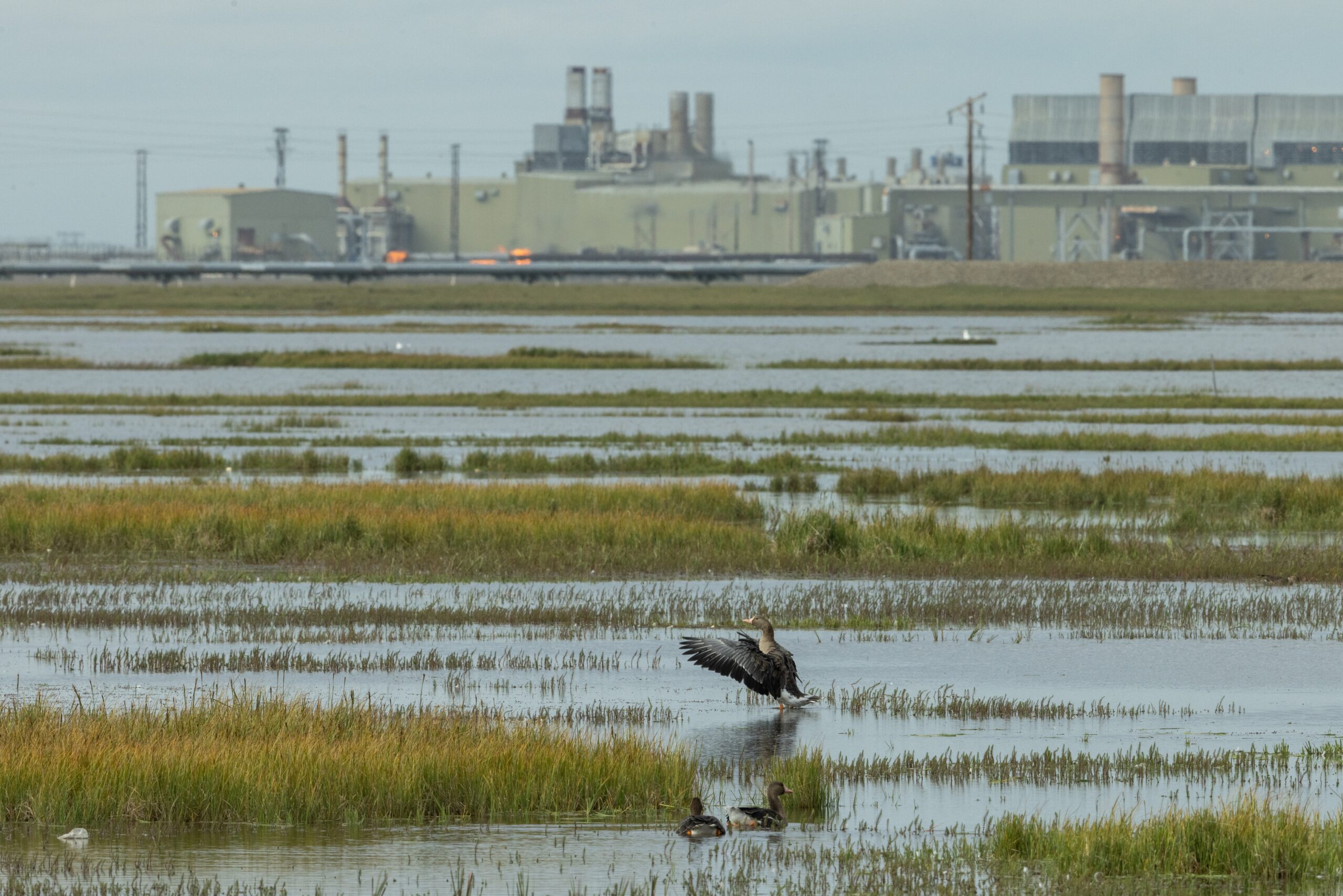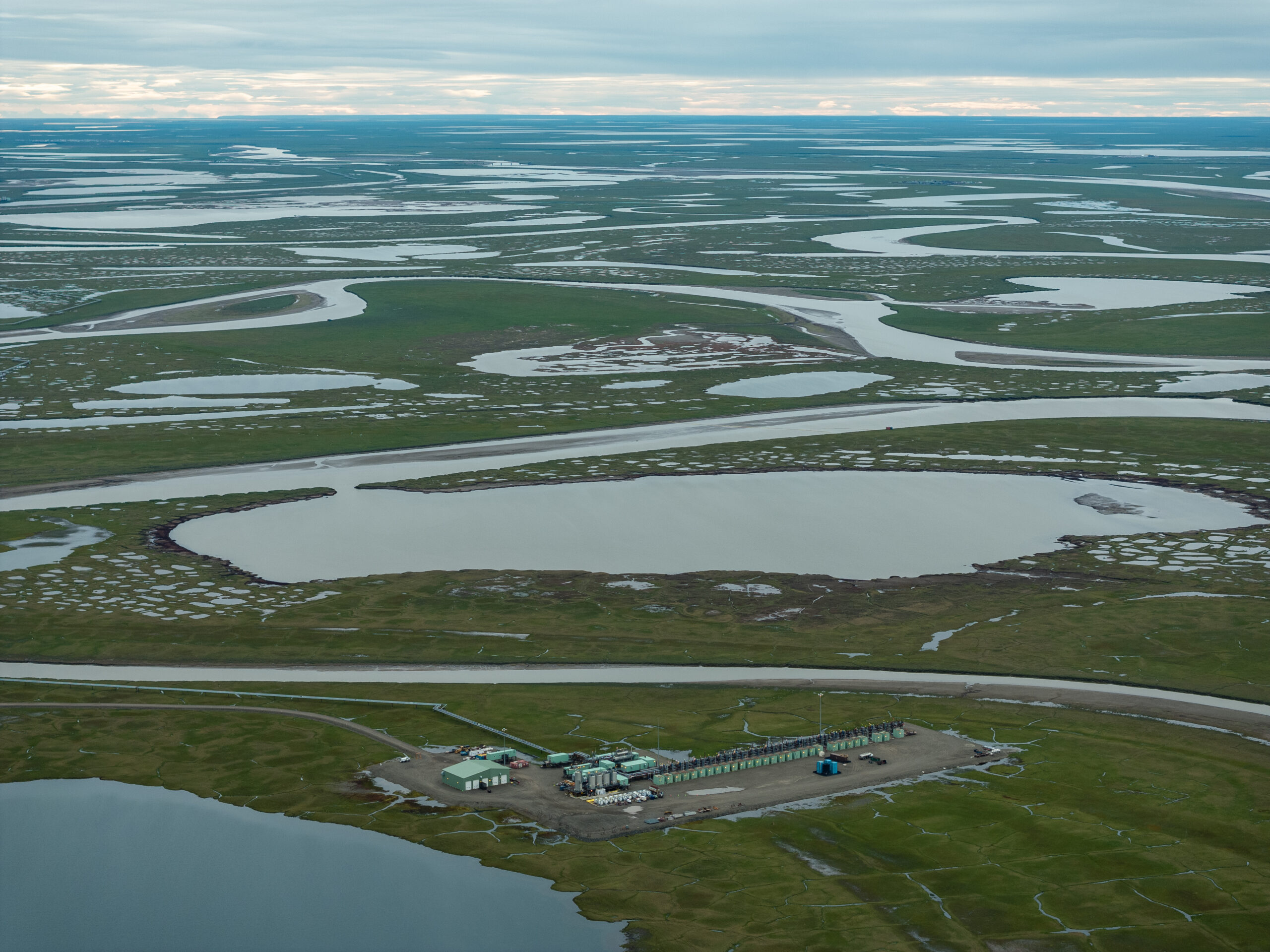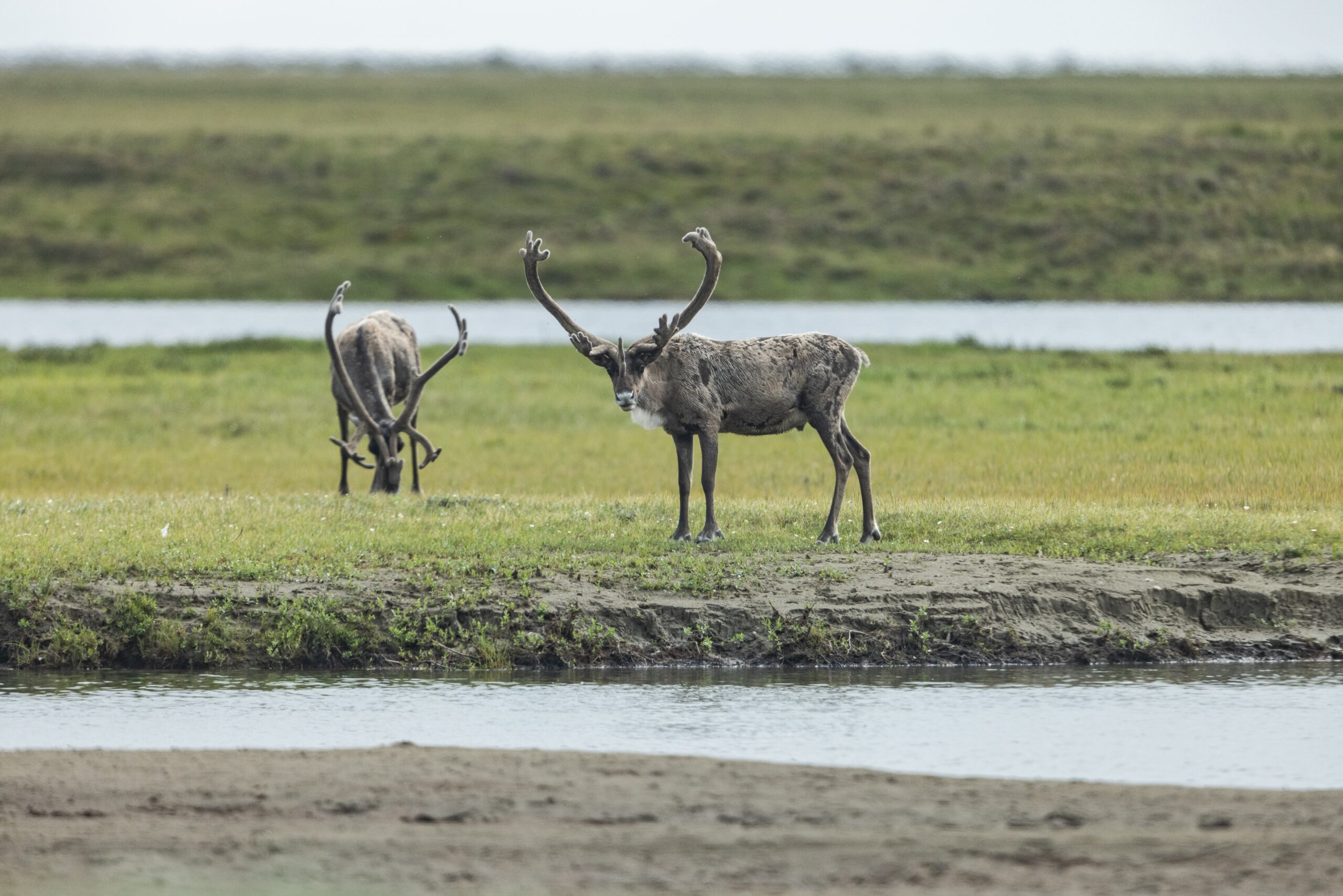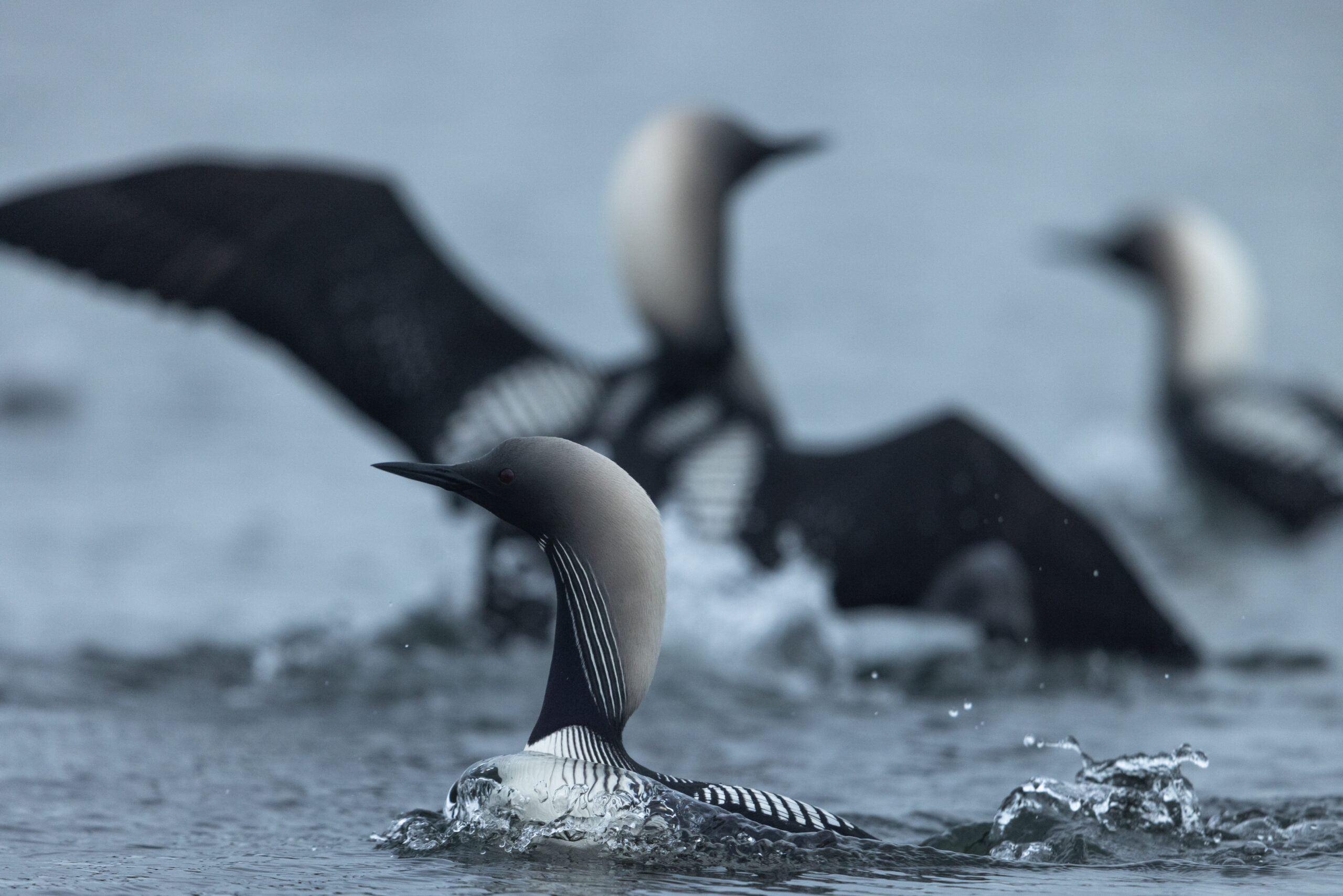The National Petroleum Reserve in Alaska may be the most misleadingly named landscape in North America. Its ungainly title conjures images of a huge oil field dotted with pumpjacks and drilling rigs—it sounds like the mirror image of the Arctic National Wildlife Refuge. In reality, the tundra landscape looks largely the same as it did in 1923, when it was set aside as a potential source of oil for the US Navy. Apart from scattered test wells drilled in the 1940s and ’50s, there has been very little industrial activity within the 23-million-acre reserve, which extends from the foothills of the Brooks Range in the west to Teshekpuk Lake in the east. Roughly the size of Indiana, the NPR-A is the biggest unbroken tract of land in the United States—a refuge for thousands of migratory birds, three of Alaska’s four northern caribou herds, and polar bears, whose winter denning habitat is disappearing as sea ice melts.
The NPR-A is, in other words, a de facto wilderness area.
Now, however, the vast sweep of wildlands is on the verge of becoming the future center of oil and gas extraction on Alaska’s North Slope. The cost of doing business and the logistics of drilling in the Far North are notoriously prohibitive, which partly explains why the NPR-A has remained untouched even as industrial activity has mushroomed around nearby Prudhoe Bay, where crude was discovered in 1968. A new oil and gas drilling effort threatens to change all that. The future of development in the NPR-A largely hinges on a single oil play: the Willow Project.
The Willow Project is an endeavor of the oil giant ConocoPhillips, which is already busy putting in place the infrastructure—roads, pipelines, and a central processing facility—to begin extraction. At full build-out, Willow will include some 200 wells that together will produce as many as 180,000 barrels of oil a day. All that oil will, of course, come with carbon pollution. Over its 30-year lifespan, the Willow Project is expected to generate more than 250 million metric tons of greenhouse gas emissions. Environmental groups have labeled it a “carbon bomb.”
It might also be a spark that detonates future carbon bombs. Environmentalists and some Alaska Native communities fear that Willow will set in motion decades of new exploration and drilling that could fundamentally reshape the Western Arctic as a rapidly warming climate destabilizes northern ecosystems. They worry that Willow will transform this corner of the Arctic into another version of Prudhoe Bay. Conoco (as the company is typically called) has promised—or, as the case may be, threatened—as much. The company describes Willow as the “next great Alaska hub” for oil development.
Such development would cause on-the-ground ecosystem damage in addition to its climate impacts. According to Jim Dau, a former biologist with the Alaska Department of Fish and Game, Willow could imperil key species such as caribou and the subsistence economies that have depended on them for generations. “Northern adapted species may be much less abundant than they were,” Dau said. “And development rarely benefits wildlife. It’s only going to accelerate declines that we are already in.”
For much of President Joe Biden’s term in office, Willow was a non-issue. In late 2022, though, a campaign largely driven by young climate activists turned it into a front-page story and a trending topic on TikTok. The White House received more than a million letters and emails urging Biden to reject the project. It was a kind of Keystone XL moment: Here was a massive oil and gas project that the president—who as a candidate had vowed to end new drilling on federal land—had the power to stop. It didn’t happen. In March 2023, Biden approved the Willow Project, to the great frustration of environmental groups. At the time, Sierra Club executive director Ben Jealous blasted the approval: “We will suffer the consequences of this for decades to come.”
That may be so. Conoco is the largest oil and gas producer in Alaska, and the company already has more than a million acres of undeveloped leases south and west of the Willow site. In presentations to investors, company officials have outlined plans to expand into what they call Greater Willow I and Greater Willow II. This model of development is one that Conoco has followed since the early 1980s when it began operating in Alaska. As production declines in one field, Conoco will move on to the next, like a timber baron clearcutting one forest plot after another.
Conoco declined to respond to questions about its long-term plans in the NPR-A, but a recently published fact sheet on its website indicates that Alaska—where 75 percent of the company’s lease holdings have not yet been drilled—remains a central part of its portfolio. According to Conoco, “Significant oil exploration and development opportunities still exist on the North Slope, with active programs underway.”
Other players have followed suit. One small company closely watching Conoco’s progress is Armstrong Oil & Gas. In 2013, Bill Armstrong, a wildcatter from East Texas, made a major discovery on the edge of the NPR-A in the Nanushuk Formation, a shallow layer of cretaceous rock that extends across the entirety of the reserve as well as a portion of state land to the east. Many wells had been drilled in the Nanushuk before but showed poor results. Armstrong, though, took advantage of newly available 3D seismic data to identify anomalies in the Nanushuk that signaled the presence of oil and gas in what is now called the Pikka field. Partnering with the Spanish company Repsol, Armstrong drilled a test well that has been credited with revolutionizing exploration and development on the North Slope.
The Pikka field, which is entirely on state land, contains an estimated 900 million barrels of oil and is considered one of the largest onshore petroleum discoveries in over 50 years. It has led to dramatically
revised resource estimates for the region and a flurry of activity by a handful of companies, including Conoco. A federal government scientist who was not authorized to speak on the record described it as perhaps the “hottest, most desirable play anywhere in the world.” And there is considerable local support for new development on the North Slope, where municipal governments and regional Native corporations have benefited from decades of drilling. Nagruk Harcharek, president of the Voice of the Arctic Iñupiat, a nonprofit representing North Slope communities, described Willow as a “win for everybody” and said future projects should be evaluated on an individual basis.
Armstrong believes that there are other Pikka-size discoveries yet to be made. In November 2017, he sold his company’s stake in the Pikka field for $850 million. Two years later, he purchased nearly a million acres of lease holdings in the NPR-A, most to the west of Willow, and has said that exploration in the reserve is in its infancy. As he told a recent gathering of industry executives and petroleum geologists in Houston, “This is wide fucking open.”
The next four years of the Trump administration will determine if Armstrong is right.

Greater white-fronted geese in a pond surrounded by oil field infastructure on the tundra west of Prudhoe Bay (also known as Deadhorse). Image: Nathaniel Wilder
Prudhoe Bay remains the largest oil field in North America, and in many ways all development on the North Slope revolves around it. It is a cliché to say that the discovery of oil there in 1968 transformed Alaska, but it is undeniably true. The oil boom led to the creation of the Trans-Alaska Pipeline, which runs from Deadhorse to the Port of Valdez, 800 miles away, as well as the 414-mile Dalton Highway, constructed along with the pipeline. As with the Klondike Gold Rush before, thousands of people flocked to Alaska seeking fortune. Many stayed. The state was also compelled to settle land claims with Alaska Natives in order to acquire the territory it needed to build the pipeline, which crosses three mountain ranges and sits atop nearly 80,000 elevated support structures that cool the ground to prevent the permafrost from thawing. This, in exchange, led to the creation of the Alaska Native Corporations, which were granted 44 million acres of land, much of it overlapping with oil, gas, and mineral resources. The legacy of oil and gas development is reflected in the Alaska Permanent Fund, an $80 billion endowment that pays every Alaska resident, including children, an annual dividend of over a thousand dollars.
The legacy is also visible as you fly west out of Deadhorse to Nuiqsut, the Native village closest to Prudhoe Bay. Pipelines, roads, and power lines snake across the open tundra. Multiacre well pads—gas flares burning and lights blazing—look like small cities dotting the landscape. All industrial activity on the North Slope leads to the Trans-Alaska Pipeline, which oil executives and elected officials have long argued needs to pump 300,000 to 350,000 barrels of oil per day to stay in operation, especially during the winter, when subzero temperatures can create technical challenges. Even though this number has been revised downward in recent years, the logic has been used to justify continued exploration and production to keep the oil flowing—and the permanent fund from withering.
Conoco owns a 36 percent stake in the Prudhoe Bay field and is one of three companies that operate the Trans-Alaska Pipeline. During the past four decades, the company has spent billions of dollars on westward expansion, first establishing the Kuparuk field and then Alpine (a.k.a. the Colville River Unit), part of which extends into the reserve. The company estimates that it will spend at least $8 billion on Willow before production begins in 2029.
But Conoco’s encroachment on traditional subsistence-use areas and the village of Nuiqsut has become increasingly contentious. In 2022, a gas leak at Alpine, just a few miles north of the village, led to the evacuation of hundreds of employees and put residents on edge. The event contributed to persistent concerns about air quality and the effects of oil and gas drilling on human health.
Conoco did not respond to questions about the impact of its development on the North Slope.
The City of Nuiqsut, the local tribal administration, and the Native Village Corporation (which typically supports development) all raised questions about Willow’s impact on subsistence resources, particularly caribou, which have historically traveled near or through the village. The site would overlap with prime caribou habitat within the Teshekpuk Lake Special Area—a 3-million-acre zone that includes the largest lake in Arctic Alaska—and could disrupt migration patterns, according to the Bureau of Land Management’s environmental analysis. The Teshekpuk caribou herd, which spends summer months south and east of the lake, is of particular concern. One of Willow’s three well pads is about 25 miles from the lake, home to the highest density of shorebirds in the circumpolar Arctic. Once completed, the well pad will create new barriers for caribou and Native hunters.

Oil field infastructure on the tundra northeast of the community of Nuiqsuit, about 15 miles from the edge of the National Petroleum Reserve-Alaska. Image: Nathaniel Wilder
All of this comes on top of existing development, which has already made it harder for Native communities to access traditional hunting grounds across the North Slope. If Conoco continues to expand west into the NPR-A, it will affect core subsistence-use areas for the villages of Utqiagvik and Atqasuk, both of which rely on the Western Arctic herd to feed their families. As the BLM concluded, continued development in these areas may result in changes to land-use patterns and “decreased opportunities to pass on knowledge about culturally important places and activities.”
Rosemary Ahtuangaruak, the former mayor of Nuiqsut and an out-spoken critic of the Willow Project, has seen this firsthand. Her family has a hunting and fishing camp on the Nigliq River, bordering the NPR-A. Four of Conoco’s well pads—all part of its sprawling Alpine field—are within a few miles of the camp. Pipelines, roads, and noise from trucks and aircraft have made it an increasingly undesirable place to hunt; Ahtuangaruak’s 11-year-old grandson has told her he will no longer go there. She said her family has been advised not to hunt near the camp because of the risk of accidentally hitting a pipeline. Plus, the proliferation of roads and infrastructure, according to Ahtuangaruak, has made it less likely caribou will wander through. “It affects the number of times we go hunt, the distances that we travel to hunt, as well as the wear and tear on our bodies and our equipment,” she said.
The cumulative effects of development can be difficult to measure, but recent studies by the US Geological Survey show that caribou, particularly pregnant females, tend to avoid roads and pipelines. According to a 2019 research paper published on the Central Arctic herd, whose summer range includes the area around Prudhoe Bay, caribou continue to keep their distance from oil and gas infrastructure even though drilling in the region has taken place for 40 years. A more recent study showed that road traffic has had long-term effects on the Central Arctic herd’s access to preferred summer habitat. With new projects and exploration on both sides of Prudhoe Bay, including on the Arctic National Wildlife Refuge’s coastal plain, caribou calving habitat will be greatly reduced across the North Slope.

Caribou in the Teshekpuk Lake Special Area. Image: Nathaniel Wilder
Industrial incursions are not the only threat caribou face. New development in the Arctic overlaps with a radical transformation of northern ecosystems as the climate continues to get hotter. The Arctic is warming four times faster than the global average; last August, temperatures in Deadhorse reached a staggering 89°F, the highest ever recorded. Summers are longer and warmer, which means caribou will likely be spending more time along the coast, seeking relief from insects in areas that also happen to be close to energy development. Climate change could also reduce the quality and distribution of plants and shrubs the herds depend on as the tree line moves farther north. And there’s now an increased likelihood of so-called rain-on-snow events, in which cycles of thawing and freezing can lead to the buildup of ice, making it difficult for caribou to move across the tundra and, in some cases, killing large numbers of otherwise healthy animals. “These are massive landscape changes affecting everything from the smallest songbirds to the mammals we study,” said Joelle Hepler, a wildlife biologist with the Alaska Department of Fish and Game.
Globally, more than 75 percent of caribou herds are declining, some precipitously. In eastern Canada, the George River herd—once North America’s largest—has crashed from a high of 800,000 in the 1990s to just over 7,000, according to the most recent figures. The Bathurst herd in the Northwest Territories has faced a similar decline, which has led the Canadian government to impose hunting bans for the first time ever. The picture is also worrisome in Alaska. The Western and Central Arctic herds have experienced significant declines in recent years, though the Central Arctic herd has begun to rebound from a low point in 2016.
The Teshekpuk herd, the North Slope’s smallest, and the Porcupine herd, which calves along the Arctic Refuge’s coastal plain, have seen their numbers increase in recent years, a rare bright spot for the species. Notably, these herds have not yet been directly impacted by oil and gas development.
Dau, the former state biologist, fears that caribou will struggle to survive in the coming decades, even under the best of circumstances. He said that climate change should be taken into account with new development projects. “This is a bad time to make things even worse on caribou,” he said, adding, “What’s bad for caribou is bad for subsistence cultures.”
Ahtuangaruak believes that the preliminary construction related to Willow has already affected the Teshekpuk herd. When we spoke in September, she said Conoco was busy building roads and pipelines to access the three sites that will connect Willow to existing infrastructure at Alpine. Prudhoe Bay is packed with contractors and heavy equipment and is busier than it’s been in decades.
“You can already see the changes,” she told me. “There should be hundreds of animals moving with the fall migration. But just stragglers are coming through. Not nearly as much as it should be.”
“There should be hundreds of animals moving with the fall migration. But just stragglers are coming through.”
Rosemary Ahtuangaruak, the former mayor of Nuiqsut
The day before Willow was approved, the Interior Department issued a press release extolling Biden’s conservation legacy in the Arctic and announced that it was preparing a rule that would provide additional protections for about 13 million acres of the NPR-A. The timing was clearly calculated to try to blunt the considerable backlash that Willow had generated among environmentalists. “The Biden administration seemed to be stung by the criticism on Willow,” said Pat Pourchot, a former senior adviser on Alaska affairs at the Interior Department under President Barack Obama who is now a board member of the Alaska Wilderness League.
Most environmental groups publicly cheered the new rule, which prohibits new leasing on about 40 percent of the reserve. But in private, many environmentalists, including Pourchot, voiced concerns that the measure could easily be rescinded by a future administration and that it did nothing to curtail the development of existing leases in the Western Arctic—the very leases that Conoco and others are most interested in pursuing. The rule was designed to enhance protections in the so-called special areas such as Teshekpuk Lake and establish a process whereby future administrations can enlarge them. But there’s a loophole: While special conservation areas give the BLM the authority to impose additional restrictions on drilling, they do not prohibit development altogether. “Those can be good protective measures, but they can be waived in special circumstances,” Pourchot said, referring to cases in which industry is interested in developing an existing lease. “They’re nothing to hang your hat on if you’re trying to protect lands.”

Pacific Loons on a pond in the Teshekpuk Lake Special Area. Image: Nathaniel Wilder
Even if the rule has not entirely satisfied the conservation community, it has made things more complicated for industry. There are likely to be more hoops to jump through to build roads and pipelines in some parts of the NPR-A and to carry out exploration work like seismic surveys. And the rule could open the door to litigation from environmental groups that are eager to delay or obstruct any new oil and gas activity in the region. The chief technical officer for Borealis Alaska Oil, a small company with about a dozen leases in the Teshekpuk Lake Special Area, has said the rule would make it harder to attract the investment needed to move ahead with the final stages of its project.
Last February, Borealis and Armstrong Oil & Gas took the unusual step of asking the BLM for a temporary one-year suspension of their lease holdings in the reserve, citing uncertainty over the new rule. The suspension means they don’t have to pay annual fees to the federal government—but nor can they begin any new development work in their lease holdings. A few months earlier, 88 Energy, another company with leases in the NPR-A, made the same request. Altogether, the suspensions totaled over a million acres, most of them held by Armstrong. (Conoco, the largest leaseholder in the NPR-A, criticized the rule but has not asked for a lease suspension.)
Around that same time, Armstrong the wildcatter, who rarely grants interviews, appeared before the Houston Geological Society, where he was greeted as a hero. He talked about what had drawn him to Alaska and how his company had made the Pikka discovery. Toward the end of the talk, he said the Biden administration’s policy in the region amounted to “theft” and a form of nationalization.
BLM officials have a different view. The agency ultimately granted the one-year suspensions requested by the companies but has asserted repeatedly that the new measures will not affect valid existing leases. The different interpretations of the rule underscore environmentalists’ concerns that the Biden administration protections may be less airtight than the White House has suggested.
Although climate and energy issues played only a minor role in the 2024 presidential contest, the election will no doubt upend energy politics. Donald Trump’s victory could very well usher in a North Slope oil boom unlike anything the Alaskan Arctic has experienced since the discovery of oil at Prudhoe Bay. The impacts will be far-reaching and, in some cases, irreversible, locking in decades of new drilling. Companies will likely move as quickly as possible to develop their remaining leases in the NPR-A, knowing that they may have only four years before another change in administration. The Trump White House will be happy to assist.

Oil field infastructure on the tundra west of Prudhoe Bay (also known as Deadhorse). Image: Nathaniel Wilder
During the first Trump term, Interior Secretary Ryan Zinke made much of the USGS’s revised estimate of the NPR-A’s oil and gas resource potential and, in a speech in Anchorage before it was released in 2017, said that the road to “energy dominance” ran through the state of Alaska. Several months later, the Tax Cuts and Jobs Act of 2017 opened the Arctic Refuge to oil leasing, and the administration began the process of fast-tracking Willow. The second Trump administration is now poised to pick up where the first left off.
Today, the industry has far more acreage in the reserve than it did at the beginning of Trump’s first term, and Conoco has already broken ground on Willow, the first step in expanding into the rest of the NPR-A. For his part, Trump now has an even more nakedly transactional relationship with fossil fuel magnates. As he sought to raise money for his campaign, he told a group of oil and gas industry executives that in exchange for $1 billion, he would happily do their bidding. This would mean, among other actions, slashing the environmental protections put in place under Biden and expanding drilling on federal lands, including in Alaska. Trump’s vision of the North Slope as one giant oil farm will guide federal policy in the region.
Environmental organizations say they are ready to oppose the Trump agenda. “On the one hand, we’ve done it before. We have a playbook,” said Kristen Miller, executive director of the Alaska Wilderness League, referring to the organization’s efforts to push back against the incoming administration’s policies. The Alaska Wilderness League and partners, including the Sierra Club, will likely lean heavily into litigation to prevent or stall additional drilling. “On the other hand, it’s a little scary how different it might be,” Miller continued.
During Trump’s first term, environmentalists’ efforts to stymie development were largely successful in part because the Trump administration was careless and sloppy in its policymaking. “He didn’t get a lot accomplished in our world, at the end of the day, in his first term,” Miller said. “We’re going to do everything we can to make sure that’s the case again.”
Whether those defensive measures will be as effective a second time around is unclear, as the Trump operation appears to be better organized now. At the very least, this much is apparent: During a moment of great ecological destabilization, Trump 2.0 could radically reshape one of the last truly wild landscapes in North America.